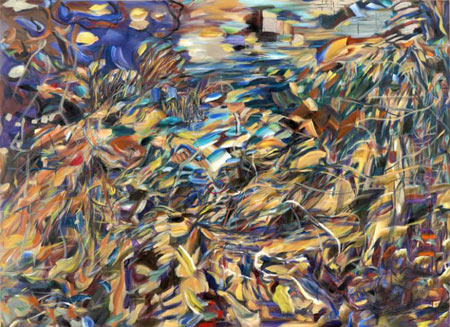
Naomie Kremer is a seasoned, internationally moored artist originally from Israel. Her decades of practice has ranged over figuration, abstraction, conceptual photography, installation, even digitized moving incarnations of gestural canvases framed on gallery walls. In the hands of a less mature artist this kind of range would ring of dilettantism. Instead what marks Kremer’s career, regardless of media, are clarity of process, intense emotion, and a doggedly relentless inquiry into the format at hand. She manages to repeat the plastic/content issues she is investigating over and over, yet they are consistently inventive.
In the 1990s when it was once again said that brush-to-linen was out (it never is), Kremer rebelliously moved precisely to the abstract painting she is best known for and which on view here. Each canvas is built of criss-crossing, entangled, thickly webbed skeins of paint cued to carefully calibrated systems of color, rhythm or mood. The ribboned, lyrical gestures can look dry and brittle as dead branches in one passage, liquid and taffy like cellular ribosomes in another, or wire thin and nervous. It is the mastery over the tensions between line quality, her control over their density, the chromatic nuances she is able to build up with colored edging that are remarkable.
In titled and untitled works abstract spindles and streaks can congeal into subtle vestiges of the physical world: a thicket of tall grass disturbed by wind, churning liquid, nature proliferated wildly. In each case, she works the surfaces so that in both large and small scale works we are actively placed “in” the motion of the marks, rather than shown a specific geography. For every place where these abstract streaks hint at tangible reality, there is an opposing and brilliant use of marks to suggest the unseen: those phenomena we know, live by but do not necessarily perceive, like entropy, energy, gravity, expansion, contraction. This is not so surprising; Kremer was raised with strong exposure to the Talmudic spiritual tradition, which studies the unseen core forces that balance order and chaos, matter and space to give material presence to the tangible world. It is just this that we sense in her works.
